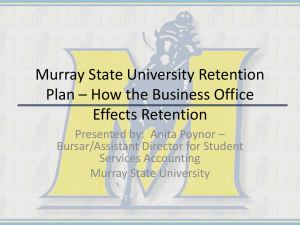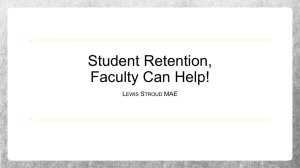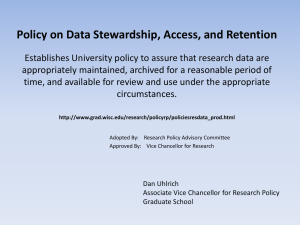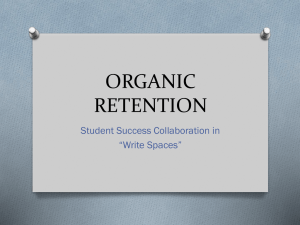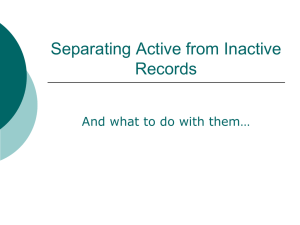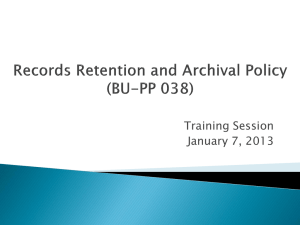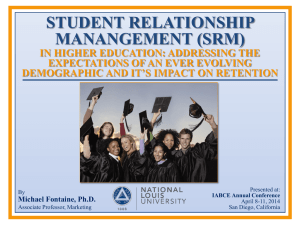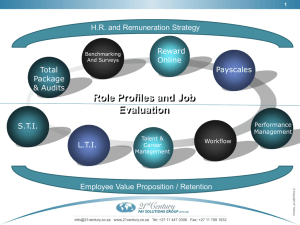Retention Efforts at Bradley University
advertisement
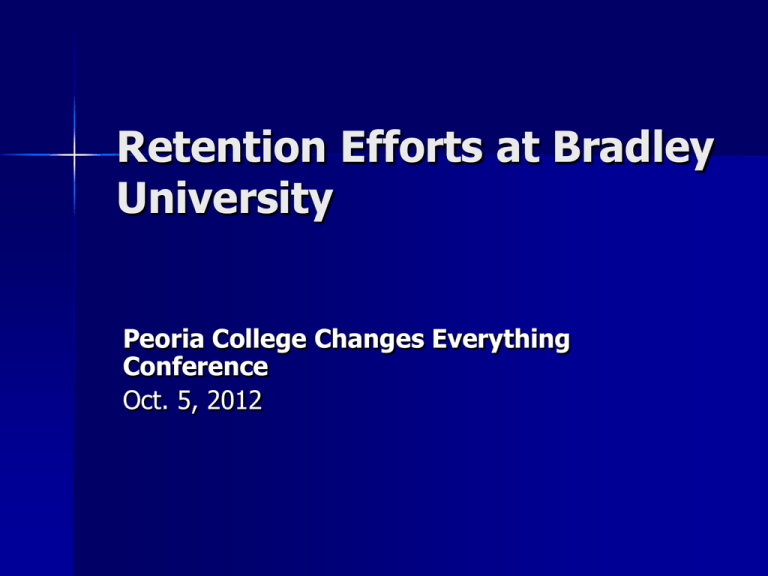
Retention Efforts at Bradley University Peoria College Changes Everything Conference Oct. 5, 2012 Preface Students have various motives for working towards graduation. Tinto, 1998 Programs for smaller groups are more effective towards retention. Pascarella and Terenzini, 1991. One retention plan does not fit all student needs. Need a myriad of faculty and staff to offer a diverse set of retention efforts. College retention rates are influenced most by the following factors: Quality of the freshman class Type of institution Faculty and Staff Campus environment for specific student body Specific retention programs Freshman to Sophomore Retention Rate of Four Year Private Institutions by Admission Selectivity Selectivity level N FreshmanSophomore Highly Selective 102 93.3% Selective 259 81.1% Traditional 450 69.8% Liberal 85 61% Open 247 65.5% All types 1143 72.8 retention rates Source: Compiled from ACT Institutional Data File, 2011. Retention programs Comprehensive approach to student retention Six key retention efforts for faculty and staff to reach at-risk students – – – – – – TPP SOAR Early Reg. notify Emergency notification Midterm Grade letter Office of Parent Relations TPP Turning Point Program Assisting students on Academic Probation Weekly, small group meetings Discuss methods of regaining academic good standing SOAR Students On Academic Reinstatement – Assist in the petitioning process – Send a letter to inform them of the program and to make an appointment during the first 2-3 days of the semester Mandatory weekly meetings with GA or professional staff member Discuss motivational and attitudinal issues Cheerleader Midterm Grade Letter Registrar provides list of all students who earned a letter grade of D or F Those students are notified with a letter to inform them of the grade and provide steps to improve those grades Students are provided contact information to the Center for Learning Assistance or Student Support Services Early Registration Contact After early registration concludes, a list of students who are eligible but have not registered is provided by the Registrar Students are contacted to encourage to enroll or suggest appropriate resources (advisor, dept. chair) If student is not planning to return, an exit interview is conducted and assistance for possible return is provided Student Emergencies Family emergencies – Parent or sibling death Personal illness – Hospitalized – Health Services diagnosis Process – Upon notification and verification, student’s professors are notified by email – Student receives a copy of the message – Student is instructed to meet with each professor upon return to campus – Intervention in the case of final exams Office of Parent Relations Respond to parental inquiries Seek out the student and discuss possible difficulties Follow up with student and parent Assessments Freshman to Sophomore Retention Rates – National figures by selectivity – Tracking each cohort class Program Retention Rates BU SUMMARY OF FRESHMAN TO SOPHOMORE RETENTION RATE Year Ret Rate Withdrew Dismiss 1990-99 82.4* 12.5 5.1 1999-00 87.3 10.5 2.2 2000-01 86.3 11.9 1.8 2001-02 85.7 11.9 2.4 2002-03 88.6 9.6 1.7 2003-04 89.2 8.8 2.0 2004-05 87.4 10.9 1.7 2005-06 87.4 9.1 3.5 2006-07 88.9 9.4 1.7 2007-08 88.1 9.4 2.5 2008-09 87.0 10.2 2.8 2009-10 87.2 10.2 2.6 2010-11 86.5 11.3 2.2 2011-12 85.9 *Average freshman to sophomore retention rate for private, selective universities – 81.1% Summary of Bradley University Graduation Rates for Freshman Cohort 1994-1998 1994 1995 1996 1997 1998 4 Year Rate 48.8% 45.9% 45.7% 49.4% 61.9% 5 Year Rate* 66.4% 63.6% 68.5% 69.1% 71.2% 6 Year Rate 67.3% 66.2% 70.2% 71.3% 71.9% 4 Year Rate of Those 73.2% 69.3% 65.2% 69.3% 86.0% Who Graduated Class Size 1009 1040 945 1073 1038 Results of Programs: Program GO FAR TPP SOAR Notification Outcomes ~60% students earn good academic standing ~65% students regain good academic standing ~55% students regain good academic standing or graduated ~10% more students register Conclusion Improving student retention requires personal attention and tailored programming Availability and approachability are critical to identifying and reaching students in distress
